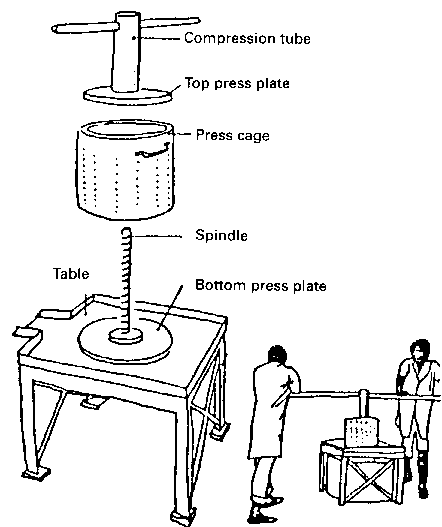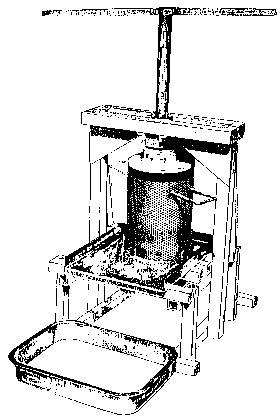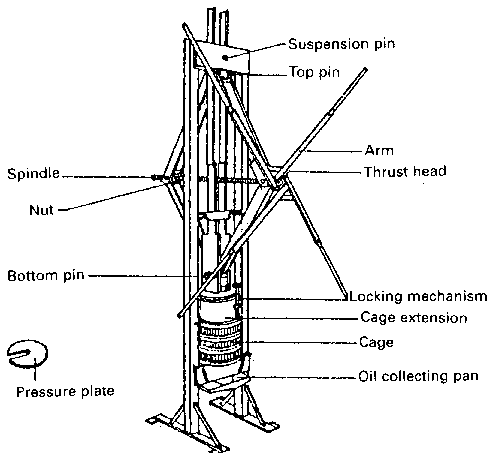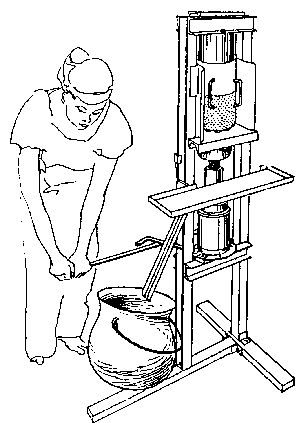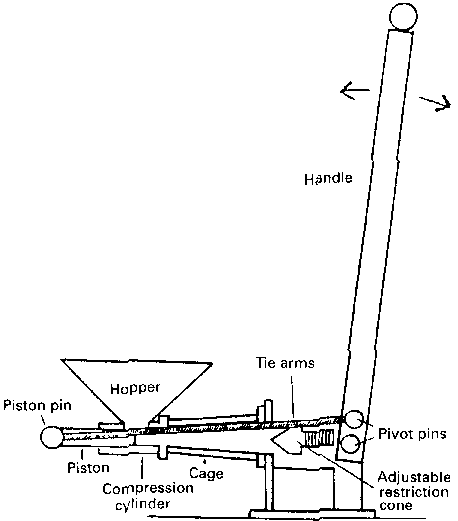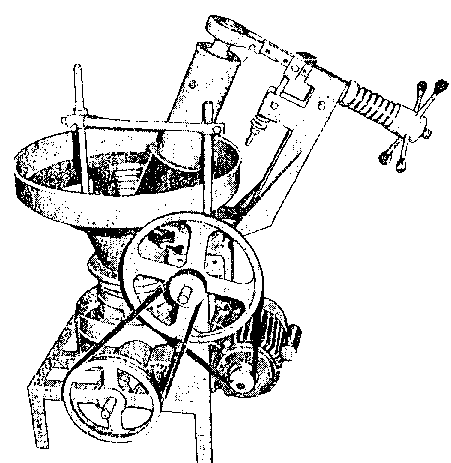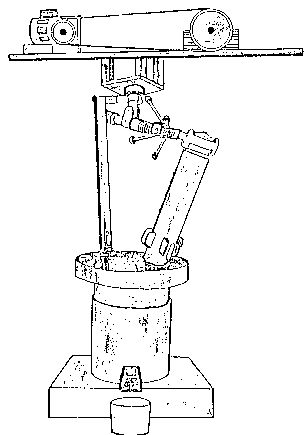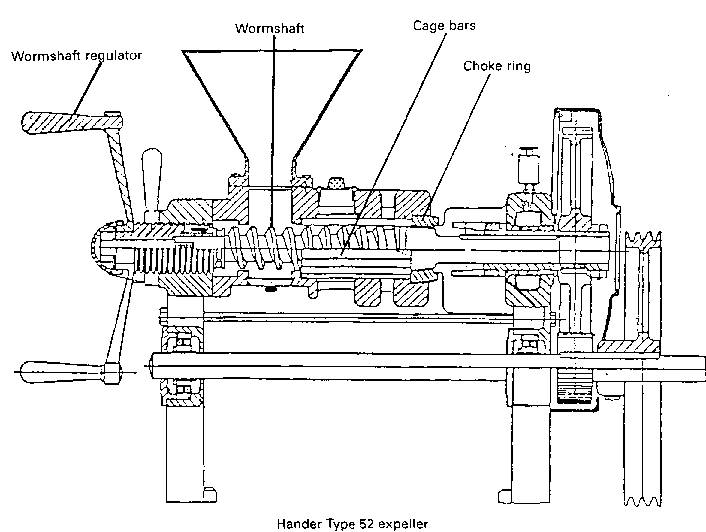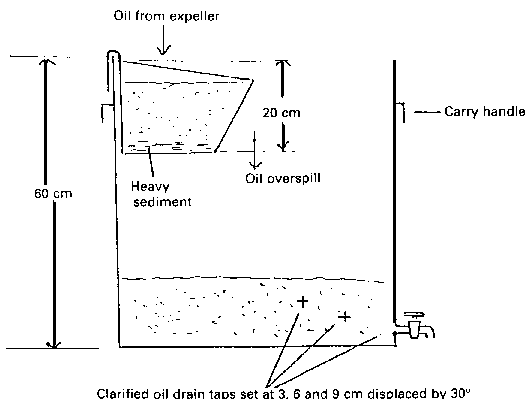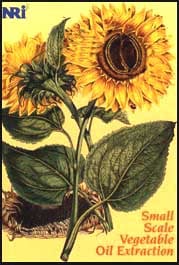
Chapter 3 - Oil extraction[edit | edit source]
Commercial oilseed processing[edit | edit source]
The following paragraphs are included to give the reader an idea of the scale and number of operations required to extract oil from oilseeds at a commercial level, and how they relate to small-scale operations. The main difference is that commercial mills refine the oil before offering it for sale as an edible product. It must be stressed that good quality unrefined oils produced by small-scale methods are in no way inferior to refined oils, and that they are, in many cases, preferred by the consumer as they retain the flavour of the oilseed.
Figures 1 and 2 are flow diagrams showing various operations common to the processing of many oilseeds. Oilseeds are delivered to the processing mills by road, rail and ship. Typically, commercial mills can process about 8000 t of oilseed per month. The oilseed is often stored for several months before processing and needs to be kept at a moisture content low enough to prevent deterioration by moulds which grow at high moisture contents. Moisture content determinations are carried out on seed batches on delivery at the factory. The mills are equipped with their own laboratories to carry out the analysis. If necessary, the seeds are then dried, ideally using special dryers, to the moisture content required for safe storage.
Seeds are stored in special silos which are often fitted with ventilators so that air can be circulated through the oilseed to keep the moisture level and temperature constant. This is necessary to prevent localized high moisture levels being produced which would encourage mould growth. To accommodate 2000 t of seed, a silo 10 m in diameter and 36 m high will be required. Conveying equipment is used to transport seed from the silos to the factory processing equipment. Either screw- or belt-conveyors are used to do this.
In the factory the seeds are subjected to a number of processing steps prior to oil extraction. The oilseed is cleaned to remove trash, dirt, sand and metal pieces. The oilseed is then weighed for accurate control of oil and cake yield. The shell or seed coat is often removed from the oilseed kernel. This process is known as decortication and, as well as raising the oil content of the raw material entering the extraction machinery, it ensures a higher protein content in the oil-cake. Size reduction of the seed is sometimes followed by rolling to produce flakes which are then conditioned. During conditioning,
Figure 1 General steps in oilseed extraction (the actual process varies between seeds and the chosen method)
Figure 2 Flow diagram of expeller press vegetable oil plant (Courtesy Anderson International Corp., Cleveland, US) the seed is heated and often treated with steam in order to rupture the oil-bearing cells and maximize the oil extraction efficiency.
Oil is extracted from the treated seed particles in continuous screw expellers. In very large plants this operation is used as a pre-treatment before solvent extraction. Solvent extraction removes the oil from a flaked seed or oil-cake by treating them with a solvent in which the oil is soluble. The solvent is removed by heat and vacuum to obtain the crude oil. Expellers will leave a residual oil content in the oil-cake of about 5-8%. Solvent extraction removes nearly all the oil, leaving only about 0.5% in the residue. Screw expellers in large mills can usually process between 10 and 100 t of oilseed in 24 h. The processing capacity of solvent extractors ranges between 100 and 1000 t/24 h.
The crude oil from the expeller is passed through screens and allowed to settle in tanks before it is filtered through a filter press. The seed residue from the settling tanks is known as 'fools'. Residues from the screens and the filter press, together with the 'fools', are re-processed in the expeller by mixing them with the fresh oilseed feedstock or oil-cake. Oil-cake is frequently passed through the expeller again to remove more oil.
As mentioned in the previous section, oil is a mixture of triglycerides which can break down on hydrolysis to produce fatty acids and glycerol or partial glycerides. Hydrolysis occurs in oilseeds by the action of enzymes present in the seeds which can become active when seeds are damaged by rough handling. If fatty acids are present they can impart an unpleasant taste to the oil and make it unpalatable. Enzymes are destroyed by heat and this is another reason why oilseeds are heat-treated prior to expelling.
Crude oil is refined in three main steps, neutralization, bleaching and deodorizing, which remove fatty acids, colour, and off-flavours, respectively. Each of these processes involves heating the oil to a certain extent. The refining processes may be carried out in stages using batch plant (see Figure 3), or by using equipment providing continuous operation. The fatty acids are neutralized by mixing the oil with a solution of caustic soda. The caustic soda solution reacts with the fatty acids to produce soap which can be washed from the oil with water. The soap solution, known as soapstock, can be used for soap manufacture. The oil is then bleached by adding a powdered clay known as 'Fuller's earth'. This operation removes coloured pigments and produces a light-coloured oil. Deodorization is carried out by passing high pressure steam through the oil under vacuum to remove the taints and odours present in the oil at the beginning of the refining process, and those produced by the neutralizing and bleaching stages. A bland-tasting oil is finally obtained.
Figure 3 Oil processing plant; a typical layout (Courtesy De Smet Rosedowns, Hull, UK)
Oil-cake is sold to animal feed compounders who blend it with other ingredients to make rations for farm animals.
Small-scale oilseed processing[edit | edit source]
Various small-scale techniques are available to enable people in rural areas to process their own oilseeds locally. Careful consideration is needed to select the system that will best suit the local circumstances. These circumstances include the scale of operation required, the availability of a power source, and a number of other factors. The options available for small-scale oilseed at levels of up to 100 kg seed/in include small powered expellers, manual- or animal-powered mechanical presses, and simple procedures using water to separate oil from oilseeds.
The following five basic oilseed processing methods are available and range from those suitable for use in domestic households, to those more suited to small-scale factories:
- oil extraction methods using water;
- manual methods using kneading;
- manual presses;
- ghanis; and
- expellers.
The ghani is, in effect, a mechanized version of the kneading method.
|
p.s.i. |
kg/cm² | |
|
Hand bridge press |
500 |
35 |
|
Small hydraulic press |
1810 |
125 |
|
Ram press |
2800 |
190 |
|
Small-scale expeller |
2500 |
170 |
|
Medium-scale expeller |
5000 |
540 |
|
Full-press commercial expeller |
20 000 |
1380 |
The pressures generally reflect the levels of oil extraction efficiencies achieved with the different types of equipment. However, the addition of a proportion of water to the ground oilseed can improve oil extraction efficiency at low pressures.
The general processing steps involved in oilseed extraction are shown in Figure 1, but actual practice varies according to the nature of the seed. In this section these processes and the major items of equipment involved are discussed. Where possible, complete process descriptions are given in Chapter 4, which deals with individual oilseeds.
Decortication[edit | edit source]
Some oilseeds have a hard outer shell which must be removed before processing. This process is called decortication. Palm kernel is an example of a seed that must be decorticated prior to processing. The extraction of oil from other oilseeds which can be processed without decorticating them first, such as sunflower, may be aided by removing a proportion of the hulls before processing.
Seed cleaning[edit | edit source]
It is essential to winnow and sieve oilseeds, prior to expelling, to remove as much dirt, dust, sand and small stones as possible. The presence of sand results in high wear on critical components of expellers such as cages, wormshafts and chokes. Using clean oilseed for expelling will greatly increase the time that the expeller can be used before replacement parts are needed.
Size reduction[edit | edit source]
Generally, small oilseeds (such as sesame or rapeseed) can be processed directly, while larger seeds (such as copra or shea nuts) need to be ground before processing. At the domestic level, grinding is usually carried out with a pestle and mortar (Plate I) while larger quantities may be ground in a village maize mill (Plate II). Hand-operated meat mincing machines can also be used in certain circumstances. The most common type of powered mill used for small-scale operations is the hammer mill.
Rolling[edit | edit source]
Rolling a seed generally results in an improvement in oil extraction by increasing the surface area of the seed while at the same time retaining channels for the flow of oil. The flakes should be very fine and preferably thinner than 0.1 mm. Rolling before processing in a bridge press is said to increase oil yields by 10% for palm kernel, groundnut and sunflower (UNATA information sheet).
Conditioning[edit | edit source]
Conditioning or 'cooking' oilseeds involves heating the oilseed in the presence of water. The water may be that which is naturally present in the seed, or it may be added. The changes brought about by conditioning are complex but include the coalescence of the small droplets of oil, present in the seed, into drops large enough to flow easily from the seed. In addition, higher processing temperatures improve oil flow by reducing the viscosity of the oil.
Oilseeds are nearly always conditioned before large-scale expelling. Small-scale expellers minimize the need for pre-treatment by using a relatively fast wormshaft speed which shears the oilseed as it passes through the expeller and produces frictional heating within the expeller barrel. This assists oil expulsion by raising the temperature of the oilseed. However, even when using a small-scale expeller, oil extraction will be assisted by heating and/or steaming the oilseed before expelling. Heat treatment is essential for some seeds with a low fibre content such as groundnuts; they must be heated and moisturized before expelling or the machine will produce an oily paste instead of oil and cake.
Some companies which manufacture small-scale processing equipment for oilseed processing refer to their seed conditioners as 'seed scorchers'. This is a misleading name because scorched oilseeds will yield oils having characteristically dark colours and burnt tastes which are not normally desirable. The Natural Resources Institute (NRI) has developed an inexpensive oilseed conditioner based on a small cement mixer (see Plate III).
Oil extraction[edit | edit source]
Wet extraction methods
In wet extraction methods water is used to extract oil from oilseeds. The distinction should be made between wet methods and water-assisted methods of oil extraction. Wet extraction methods involve the use of a relatively large amount of water so that the oilseed is suspended in the water and the extracted oil floats on the surface.
Water-assisted methods involve the addition of a small quantity of water to the oilseed before the oil is extracted by manual kneading. These methods are discussed later. They are not classified as wet methods because all the water used is absorbed by the oilseed and no separate water layer is apparent.
The hot water flotation (HOOF) method of edible oil extraction is traditionally used in the rural areas of many developing countries. Usually, decorticated oilseed is used. The oilseed kernels are heated and ground by pounding in a pestle and mortar. The ground seed is then suspended in boiling water and boiled for at least 30 min. Liberated oil floats to the surface. Further quantities of water are sometimes added after boiling to replace that lost by evaporation, and to encourage the oil to float to the surface. The oil is carefully scooped from the surface of the water using a shallow dish and is then heated over a fire to remove residual moisture.
The advantage of the HWF method over other small-scale oilseed processing techniques, such as those using expellers or ghanis, is its simplicity. The equipment required (pestle and mortar, boiling pans, etc.) is readily available. However, oil yields tend to be low and the process can be time consuming and arduous. This is especially true if traditional pestle and mortar methods are used to grind the oilseed kernel. If long boiling times are used, fuel consumption will also be high.
The above method may be applied to most oilseeds with varying degrees of success. Sources of oil, such as coconut and oil palm fruits, can be processed by traditional methods which make use of the water already present in the seed (see Chapter 4).
Manual methods using kneading
In common with the water flotation process, only simple domestic utensils are needed to extract oil by kneading. This method is used to process groundnuts traditionally in West African villages and is described in detail in Chapter 4. Water is added to groundnut paste and the mixture is stirred and kneaded by hand until the oil separates. The water plays a vital but obscure role in the extraction process. It is believed that the water displaces oil from hydrophilic, or 'water loving', surfaces in the ground seed.
Manual presses
A selection of the many different types of manual press employed in oilseed processing are illustrated in Plate IV and Figures 4-10. With the exception of the ram press, these can be used for all types of oilseeds. To get the best oil yields, pressure on the prepared oilseed should be applied slowly and increased gradually.
The wedge press
The wedge press, operated manually or by using either wind or water power, was widely used to press oilseeds during the late 18th and early 19th centuries in the West and in the Far East. The typical operating principle of a wedge press used during this period is shown in Figure 4. Figure 5 shows the design of a wedge press using trees as the end braces (Broadright, 1979). The wedges should be made of a very hard wood and are best driven in with a wooden mallet. Two wedges should be applied, one from each side, and these should be driven in simultaneously so as to avoid pushing both bags and wedges out of the press.
Figure 4 Operating principle of a wedge press
The plank press
The plank press represents the simplest mechanical pressing device used in oilseed processing. It consists of two long pieces of wood hinged at one end. The prepared seed, in a suitable woven container, is placed between the planks and squeezed by the application of pressure at the unhinged ends. Plate IV shows a plank press being used in Nepal for the extraction of rapeseed oil.
Figure 5 Design of a wedge press (Broadright, 1979)
Cage presses
Cage presses have formed the basis of many small-scale processing operations in recent years and are sometimes called screw presses, but this name should be avoided as it can be confused with the continuous screw expeller. There are a number of cage press designs and four types are shown in Figures 6-9. In a variation of the version shown in Figure 9, the hydraulic jack is mounted above the pressing cage. This design is not recommended because of the risk that leaking hydraulic fluid could contaminate the oil and cake.
The curb press The press shown in Figure 6 was designed by the Technology Consultancy Centre (TCC) at Kumasi in Ghana. It is a development of the 'Duchscher' curb press which was manufactured in Luxembourg and which has been widely used in Nigeria for extracting palm oil. The cage on the TCC press is made of two halves hinged on one side and locked together with a pin on the other. This enables the cage to be opened easily for unloading the oil-cake after pressing. This makes the press particularly convenient for processing palm fruits, but the central position of the screw inside the cage makes the press unsuitable for pressing other oilseeds.
Figure 6 Curb press (TCC design)
The bridge press In the bridge press, the press plate is mounted at the base of a screwed rod (often incorrectly referred to as a spindle) which runs in a nut set in the 'bridge' of the frame that surrounds the cage. The screwed rod is turned by a single cross-head bar providing two levers.
Figure 7 shows the bridge-type cage press used by NRI. The design incorporates a thrust bearing which allows the screwed rod to rotate easily against the pressure plate. The original press used a 24 cm diameter cage and was designed to produce the relatively low pressures required for extracting oil palm fruits. To adapt the press to higher pressure use so that it could be used for a range of oilseeds, the diameter of the cage was reduced to about 15 cm together with a corresponding reduction in the diameter of the press plate. This reduction in the cage diameter increased the maximum pressure exerted on the seed from the 14 kg/cm² (200 p.s.i.) available in the larger cage, to 34 kg/cm² (500 p.s.i.) in the smaller cage. The increase in pressure obtained can be demonstrated as follows.
The area of the press-plate for the larger cage is:
3 x 12 cm x 12 cm = 452 cm²
The maximum pressure that can be exerted on this plate is 14 kg/cm². Therefore, the maximum force exerted at the end of the screwed rod on the pressure plate is:
14 x 452 = 6328 kg, a little over 6 t
The area of the plate in the smaller cage is:
- 14 x 7.5 cm x 7.5 cm = 176 cm²
Thus, the maximum pressure available in the smaller cage is:
6328 kg/cm² = 36 kg/cm²
Figure 7 Bridge press (NRI design)
Since the height of both cages is 200 mm, the capacity of the 150 mm cage is 3.5 l, and that of the 240 mm diameter cage is 9.01. Thus, increasing the pressure on the oilseed by decreasing the diameter of the cage results in a reduced cage capacity and hence reduces the amount of oilseed that can be processed.
The scissor press This press (Figure 8) was designed by the Institute of Production Innovation (IPI) in Dar es Salaam, Tanzania, as part of a complete set of equipment for processing sunflower seed by hand. It is understood that this type of press can exert a force of 80 t.
Figure 8 Scissor press (IPI design)
The hydraulic press A simple form of this type of press is shown in Figure 9. It was developed by KIT for processing shea nuts and was based on a 30 t lorry jack which exerted a maximum pressure of 125 kg/cm² on the seed. The cage capacity is 8 1.
Figure 9 Hydraulic press (KIT design)
The ram press
The prototype ram press was designed in 1985 by Carl Bienlenberg, an engineer working with Appropriate Technology International (ATI). The layout of this press is shown in Figure 10. A long, pivoted lever moves a piston backwards and forwards inside a cylindrical cage constructed from metal bars spaced to allow the passage of oil. At one end of the piston's stroke an entry port from the seed hopper is opened so that seed can enter the press cage. When the piston is moved forward, the entry port is closed and the oilseed is compressed in the cage. As a result, oil is expelled from the oilseed and emerges through the gaps in the cage. Compressed seed is pushed out through a circular gap at the end of the cage. The width of this gap, which can be varied using an adjustable pressure cone, controls the operating pressure of the press. The design of the press is such that it can achieve operating pressures greater than those obtained in most manually-operated cage presses, and as high as those in small expellers. The ram press has a low seed throughput but has the advantage of continuous operation.
Figure 10 The ATI ram press
The ram press was developed in Tanzania specifically for processing a thin shelled high oil-content variety of sunflower seed known as 'Record'. Presently, the technique is being applied to copra, groundnuts and sesame. The original ram press, the Nand Singh type, had a large cage and normally needed two people to operate it. The Nand Singh press has now been replaced by two smaller versions, the CAPU and the CAMARTEC (see Appendix 2), which only require one operator. The CAPU press was designed by engineers from the Craftsmen and Artisans Promotion Unit, while the CAMARTEC press is the product of the Centre for Agricultural Mechanization and Rural Technology. The CAMARTEC press is a small machine designed to be easy for women to operate. The development of the ram press has been described in ATI bulletin No. 24, published in August 1992.
Ghani
A ghani (also known as a 'chekku' or 'kol') is a mortar and pestle device which grinds oilseed into fine particles and extracts the oil from it. Ghanis are used extensively in the Indian sub-continent to process mustard seed, sesame seed, copra and groundnuts. The mortar is fixed to the floor and is normally made from wood. The pestle can be made from either wood or stone. Usually the power source is a bullock harnessed to a long lever arranged to turn the pestle inside the mortar (see Plate V). A batch of oilseed is loaded into the mortar. As the bullock moves the lever around the mortar, the pestle grinds the oilseed inside. After the seed has been ground, a certain amount of water is added. The water combines with the ground oilseed, releasing oil which is expelled by the kneading action of the pestle through a hole in the bottom of the mortar; the oil is collected in a container. When the ghani operator is satisfied that a good yield of oil has been extracted from the seed, the ghani is brought to a halt and the oil-cake is removed. Another batch of seed is placed in the mortar and the process is repeated. A typical bullock-driven ghani can process about 10 kg seed every 2 h. The bullock normally becomes fatigued after working the ghani for about 3-4 h and is replaced by another one.
Electrically-powered ghanis, known in India as 'power ghanis', are now replacing bullock-driven ghanis because bullocks are becoming increasingly costly to maintain. Either the pestle or the mortar is held stationary in power ghanis (see Figures 11 and 12) which are normally run in pairs so that one is always operating while the other is being discharged. About 100 kg seed/ day is the usual throughput.
The advantages of the ghani are that it produces a reasonable oil yield of about 60%, it can be made locally, and it has low running costs. Oil produced in a ghani is usually valued for its quality. In addition, no pre-grinding equipment is needed for smaller oilseeds such as groundnuts, rapeseed, sesame and sunflower seeds, and it is suitable for use by small groups in villages.
Figure 11 Power ghani with stationary pestle
Figure 12 Power ghani with stationary mortar
Expellers
Principle of operation
Oilseed expellers produce oil and oil-cake from oilseed continuously, unlike bridge presses which operate on a batch system. The essential components of a typical small-scale expeller are shown in Figure 13. The expeller is driven either by an electric motor or by a diesel engine. At the heart of the machine is a powered wormshaft which rotates inside a closely fitting cage. The oilseed is fed continuously into the press through a hopper and is crushed as it is transported through the cage by the wormshaft. Pressure is exerted on the system by restricting the gap at the end of the cage through which the oil cake is discharged from the press. The expelled oil drains out of the cage through small gaps.
Figure 13 Outline drawing of a typical small-scale expeller (CeCoCo Type 52)
The friction generated inside the expeller barrel will eventually result in the wearing down of the wormshaft end portion, barrel bars or rings, and choke. Replacement of these parts will be required at intervals depending on the type and amount of oilseed processed and the degree of dirt contaminating the seed. Rapid wear is a particular problem when expelling undecorticated, dirty sunflower seed. The availability and cost of wearing parts are important considerations when setting up a small-scale expeller facility.
General method of operation for expellers having an adjustable choke
Starting up the press
- Before starting up the drive to the press, check that all the safety guards are in good order and the machine has been lubricated according to the manufacturer's instructions. Ensure the choke control is adjusted so oil-cake can be discharged from the press cake outlet.
- Start the press drive and check that the wormshaft is turning over correctly. Then begin feeding the oilseed very gradually by hand into the hopper. The screw press will not expel oil satisfactorily until the barrel is hot. The operating temperature required varies according to the type of oilseed processed, but it is normally between 60 and 100°C. Some oilseeds (such as copra) have a fibre content which provides the friction needed to heat the barrel. Softer oilseeds (such as groundnuts and sesame seed) first need to be heated and conditioned in order to reach a satisfactory operating temperature (see Chapter 4 for details of oilseed conditioning). When expelling the softer seeds, the time taken to reach the operating temperature can be reduced considerably by feeding the press cautiously by hand with crumbled oil-cake of the seed being processed. As the barrel temperature increases seed should be mixed with the oil-cake in progressively increasing proportions so that finally only oilseed is being fed to the press. In some circumstances it is beneficial to use a mixture of oilseed and oil-cake all the time.
- When the seed material has been discharging freely from the press cake outlet for a few minutes, the choke may be reduced gradually to increase the pressure within the press and improve the quality of the oil-cake and the oil flow from the press barrel. The optimum cake thickness for a small-scale expeller is usually about 1-2 mm.
- The choke is adjusted by the wormshaft regulator at the feed end of the machine. Turning the handles anti-clockwise moves the taper plug section of the wormshaft axially further into the taper bore of the choke ring, thus reducing the thickness of the cake. Turning the wormshaft regulator clockwise withdraws the shaft and increases the cake thickness. The locknut (if fitted) has to be released to allow the operating screw to move and should be relocked after each adjustment.
- Until the barrel reaches the operating temperature, a large amount of sediment 'fools' may be produced with the oil. To limit this, oilseed should be fed slowly to the press during the warming-up period. However, some oilseeds do not produce a large amount of sediment with the oil during the start-up period. In this case, the rate of feed may be increased more quickly until optimum operating conditions are reached. Once uniform operating conditions have been reached, the sediment can be gradually mixed in with the oilseed fed to the press.
Normal operation of the press When uniform operating conditions have been reached, the objective should be to produce the best quality of oil-cake possible, consistent with the required throughput of the press. It is possible to process some oilseeds without needing to restrict the rate at which they are fed to the press. In other words, with the feed control slide on the hopper fully open, the press will continue to operate in a uniform and steady manner, drawing oilseed from the full hopper.
There are occasions, however, when the feed has to be metered to the press. Metering can be necessary for processing the more fibrous seeds such as palm kernels and copra. This is because the power required can be much greater than that needed to process softer seeds, and so the feed rate has to be restricted to keep the power required within the power limitation of the driving unit. In this event, if laborious manual feeding is to be avoided, the press may be fed by some metering device such as a variable delivery vibrator or screw feeder from a hopper or storage bin.
Metering is also necessary when palm kernels, copra and other large seeds are broken, or coarsely ground, before feeding to the press. In this condition they will not easily flow steadily into the press feed area and therefore may have to be metered either by hand or, preferably, from a vibratory feed. Some seeds need to be pressed a second time to obtain optimum extraction of the oil. Again, the cake from the first pressing may not flow satisfactorily from a full feed hopper and may need to be metered to the press.
Palm kernels are described above as usually being broken or coarsely ground before processing but, with caution, they can be first-pressed as whole kernels from a full open feed. However, a metered feed may be needed to recycle the oil-cake from the first pressing.
When feeding from a full feed hopper, the flow characteristics of some materials through the press may be exceptionally good and result in a press capacity higher than required. If this condition occurs, the resulting residual oil in the cake tends to be high. A lower, more acceptable oil-in-cake result may usually be obtained by metering the seed to the press at a reduced rate.
Oil clarification methods[edit | edit source]
Freshly extracted vegetable oil may contain suspended seed debris which gives the oil a cloudy appearance. The quantity of solid material in the crude oil depends on the method used to process the oilseed and the type of seed processed. Oil produced from expellers contains substantial quantities of seed debris. Oil from manual presses and traditional processes contains smaller quantities of debris. To produce a clarified oil, the solids must be removed from the crude oil. Oil clarification methods are described below.
Clarification by settlement
Freshly extracted oils are left to stand in a small oil drum or bucket for several days to allow solids to settle. After settlement, the clear supernatant oil can be poured or siphoned off, leaving the plant debris at the bottom of the container. These settled solids are called foots.
Recovery of oil from foots
Oil can be recovered from the settled foots by:
(a) filtering through finely-woven material into a container;
(b) heating the foots with a small quantity of water in a metal basin. This coagulates the solid material. The mixture is boiled to remove water, leaving a mixture of partially-separated oil and coagulated solids. This is then filtered through muslin to produce clarified oil. The solids retained on the muslin can be squeezed by hand in a cloth to remove any residual oil.
Oil clarification by boiling with water
A mixture of freshly-extracted oil is heated strongly with water (10% by weight of oil). Frothing of the oil will occur when most of the water has been driven off. When this takes place, oil can be poured off, leaving the coagulated solids at the bottom of the container. A skilled operator will leave a solid residue which contains only a small amount of residual oil. However, if the residue appears particularly oily, it can be squeezed in a cloth to recover further quantities of oil.
Oil recovered by the boiling method will sometimes contain a small quantity of fine plant debris which can be removed by filtration through a piece of cloth spread over a bucket.
Oil clarification and expeller operation
Crude oil from an expeller tends to contain high levels of sediment, usually about 10-15%. A convenient oil collection vessel (shown in Figure 14) is constructed from a 200 l oil (45 gal) drum. The coarse foots which separate in the primary collection vessel may be added in small amounts to the fresh seed for reprocessing, but the fine sediment, when isolated (normally either by standing or in a filter press), is best used as a fertilizer or admixed with the cake.
The provision of a filter press in any small-scale expeller plant is worth considering. Filter press design has been described by Thieme (1968).
Figure 14 Oil collection and sedimentation vessel
The importance of quality in small-scale processing[edit | edit source]
Oil deterioration tends to lead to increased levels of FFA, poor colour, and flavour changes. Although poor quality oils can be purified or refined using large-scale equipment, this results in a loss of material. Also, since it is difficult to carry out at a small-scale all the refining stages that are possible in large-scale equipment, it is very important to ensure only high quality oil is produced. Steps to ensure this are enumerated below.
- As far as possible, purchase good quality seed free from mould.
- Store the seed under clean dry conditions.
- Process the seed on a 'first in, first out' basis, i.e. the oldest seed is processed first.
- If the seed needs to be ground before the oil is extracted, only grind the amount required for each day's processing. The oil in ground seed tends to deteriorate rapidly and so ground seed should never be stored.
- Clarify crude oil from the extraction process as soon as possible after production and store it in clean dry containers. The presence of solid matter in oils invariably leads to deterioration.
- Bottles and containers used for the sale of oil should be both clean and dry. They should be kept as full as possible and sealed so as to limit contact with oxygen from the air.
References
ANON. (1984) Early American oil mill described in new book. Oil Mill Gazetter, 89(5).
ANON. (1987) A study of the village ghanis aided by Khadi and Village Industries Board. Indian Coconut Journal, March 1987: 11-13.
BEAUMONT, J. H. (1981) A hand-operated bar mill for decorticating sunflower seed. TPI Rural Technology Guide 9. Chatham, UK: Natural Resources Institute.
BEAUMONT, J. H. (1981) A hand-operated disc mill for decorticating sunflower seed. TPI Rural Technology Guide 10. Chatham, UK: Natural Resources Institute.
BEAUMONT, J. H. (1981) A hand-operated winnower. TPI Rural Technology Guide 11. Chatham, UK: Natural Resources Institute.
BLAKE, J. A. (1982) Evaluation of an on-farm press: pp. 247-251. In: Proceedings of the International Conference on Plant and Vegetable Oils as Fuels, Fargo, ND, August 1982. St Joseph, MI: American Society of Agricultural Engineers.
BRACE, H. W. (1960) History of seed crushing in Great Britain. Essex, UK: Anchor Press Ltd.
BROADRIGHT, J. H. (1979) A wedge press for oil extraction. Appropriate Technology. 6(2): 24-25.
CHUNGU, A. S., KAUNDE, O. K. and PROTZEN, E.Th.P. (1987) Development of village and homestead oilseed processing equipment. Presented at the Workshop on Expert Consultation of Rural Vegetable Oil Expression and Utilisation in the SADCC Region, Zanzibar, November 1987.
DIETZ, H. M., METZLER, R. and ZARATE, C. (1989) Village scale oil processing: review of the current state of screw expellers and strategies for its upgrading. Eschborn, Germany: GATE.
GILLING, J. and CROPLEY J. (1993) Needs assessment for agricultural development: practical issues in informal data collection, NRI Socio-economic Series 1. Chatham, UK: Natural Resources Institute.
GITTINGER, J. P. (1982) Economic Analysis of Agricultural Projects. 2nd edn. Baltimore, US: Johns Hopkins University.
HEAD, S. W., HAMMONDS, T. W. and HARRIS, R. V. (1989) Experiences with small-scale oil expellers in developing countries. In: A Symposium on Edible Oil Processing, Rugby. The Institution of Chemical Engineers.
HEAD, S W., HARRIS, R. V. and SWETMAN, A. A. (1990) An inexpensive oilseed conditioner. Appropriate Technology, 17(2): 28-30.
KARNATAKA STATE KHADI AND VILLAGE INDUSTRIES BOARD (1984) Proceedings of the Regional Seminar on Village Oil Industry. India.
KHAN, L. M. and MANNA, M. A. (1981) Expression of oil from oilseeds. Paper number MCR-81-509 presented at the 1981 Mid-Central Region Meeting of the American Society of Agricultural Engineers, Ramada Inn, St Josephs, Missouri, March, 1981.
OKURA NAGATSUNE (1836) On oil manufacturing. A 1974 English translation of the original Japanese edition has been published by Olearius Editions, New Brunswick, US.
OTTO, J. (1992) The ram press of Tanzania: Successful technology gets better. Food Chain, (5): 6-7.
PINSON, G. S., MELVILLE, D. J. and COX, D. R. S. (1991) Decortication of tropical oilseeds and edible nuts. Natural Resources Bulletin 42. Chatham, UK: Natural Resources Institute.
SIVAKUMARAN, K. and GOODRUM, J. W. (1988) Laboratory oilseed processing by a small screw press. Journal of the American Oil Chemists' Society, 65(6): 932-935.
THIEME, J. G. (1968) Coconut oil processing. FAO Agricultural Development Paper No. 89. Rome: FAO.
UNIDO (1986) Manual for the Preparation of Industrial Feasibility Studies. Vienna: UNIDO.
VADKE, V. S. and SOSULSKI, F. W. (1988) Mechanics of oil expression from Canola. Journal of the American Oil Chemists' Society, 65(7): 1169-1176.
